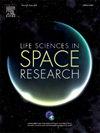Directional astronaut radiation dose for hemispherical galactic cosmic ray irradiation
IF 2.8
3区 生物学
Q2 ASTRONOMY & ASTROPHYSICS
引用次数: 0
Abstract
While galactic cosmic rays (GCRs) are inherently isotropic, in several important cases they are constrained to certain solid angle region. This directional irradiation leads to non-trivial deviations in radiation exposure from simple solid angle proportionality, since human organs/tissue sensitive to radiation also exhibit distinct spatial orientations within body. In this paper we investigate GCR incidence patterns through two characteristic geometries: the upper and anterior (front) hemispherical incidence relative to the ICRP110 human voxel phantom, and make comparison with the isotropic incidence. The fluence-to-dose-equivalent conversion coefficients are calculated by the particle physics Monte Carlo toolkit GEANT4, for all the ions and energy points for each ions. Our analysis encompasses both the unshielded configuration and a shielded configuration with a uniform 5 g/cm aluminum shell, approximating spacecraft habitat shielding. We found that upper hemispherical incidence demonstrates dose coefficient variation compared to the isotropic baselines, while anterior incidence exhibits pronounced higher dose coefficients within the 10 MeV/n to 1000 MeV/n energy range for the unshielded configuration. Dose equivalent rates with hemispherically filtered GCR fluxes show corresponding differences. Interestingly the deviation from solid angle proportionality can be utilized, that strategic astronaut orientation (Earth-facing with eastern alignment) may reduce cumulative radiation exposure by .
半球形星系宇宙射线辐照的定向宇航员辐射剂量
虽然银河宇宙射线本身是各向同性的,但在一些重要的情况下,它们被限制在一定的立体角区域。由于对辐射敏感的人体器官/组织在体内也表现出明显的空间取向,因此这种定向照射会导致辐射暴露与简单的立体角比例性产生重大偏差。本文通过两种特征几何图形:相对于ICRP110人体体素幻体的上半球和前(前)半球入射来研究GCR的入射模式,并与各向同性入射进行比较。通过粒子物理蒙特卡罗工具包GEANT4计算了所有Z=1−28个离子和每个离子27−36个能量点的影响-剂量当量转换系数。我们的分析包括非屏蔽配置和屏蔽配置,其均匀的5 g/cm2铝外壳,近似于航天器栖息地屏蔽。我们发现,与各向同性基线相比,上半球入射的剂量系数变化约为10%,而在非屏蔽配置的10 MeV/n至1000 MeV/n能量范围内,前半球入射的剂量系数明显高出约80%。半球形过滤GCR通量的剂量当量率显示出相应的差异。有趣的是,可以利用与立体角比例的偏差,即宇航员的战略方向(面向地球与东方对齐)可以减少累积辐射暴露约15%。
本文章由计算机程序翻译,如有差异,请以英文原文为准。
求助全文
约1分钟内获得全文
求助全文
来源期刊

Life Sciences in Space Research
Agricultural and Biological Sciences-Agricultural and Biological Sciences (miscellaneous)
CiteScore
5.30
自引率
8.00%
发文量
69
期刊介绍:
Life Sciences in Space Research publishes high quality original research and review articles in areas previously covered by the Life Sciences section of COSPAR''s other society journal Advances in Space Research.
Life Sciences in Space Research features an editorial team of top scientists in the space radiation field and guarantees a fast turnaround time from submission to editorial decision.
 求助内容:
求助内容: 应助结果提醒方式:
应助结果提醒方式:


